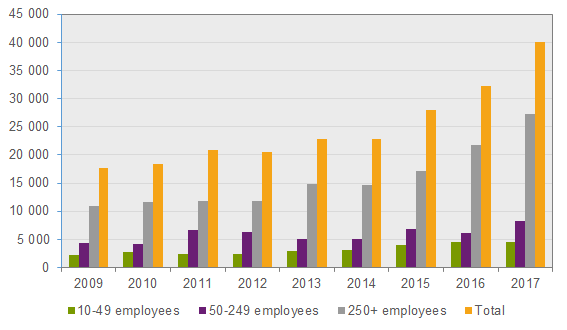Enterprises' IT expenditure, 2017
IT expenditures increased in large enterprises
Statistical news from Statistics Sweden 2018-10-19 9.30
Total hardware and software expenditures in 2017 amounted to SEK 65.2 billion. This is an increase of more than 18 percent compared with the previous year. The largest enterprises (250 employees or more) increased expenditures by more than 20 percent compared with 2016. Among the largest enterprises, software accounted for 68 percent of expenses. Among smaller enterprises, expenses remained largely unchanged.
Enterprises’ expenditures on computer equipment amounted to SEK 14.3 billion in 2017. This is an increase from 2009, when expenses for computer equipment amounted to SEK 10 billion.

Enterprises’ expenditures for telecommunication equipment amounted to SEK 10.8 billion in 2017. Information and telecommunications enterprises accounted for more than half of these expenses (SEK 6 billion). The largest enterprises increased expenditures on telecommunication equipment by 27 percent.
Software costs vary between industries
Purchases of software accounted for more than half of enterprises’ total IT expenses. The financial and insurance industries accounted for the largest share of these expenses. The largest enterprises increased expenses on software by 25 percent; at the same time, changes in expenditures among smaller enterprises (10-49 employees) remained within the statistical margin of error.

Figure 3 shows the seven industries with the highest software expenses compared with 2009. The growth of software expenses to a relatively largely extent vary between the industries. Other service providers showed the lowest increase between 2009 and 2017 at roughly 46 percent in software expenditures. In contrast, software expenditures in the finance and insurance industry increased by approximately 200 percent. The trade industry tripled expenditures on software during this period.

Enterprises’ purchases of IT services continued to increase
In 2017, enterprises’ purchases of IT services amounted to more than SEK 76 billion, while enterprises’ IT leasing amounted to SEK 5.8 billion.
An IT service means that enterprises might purchase IT services rather than purchasing computers. IT services can include service, maintenance, and more, and are carried out by an external supplier either externally or internally at the enterprise.
This year’s survey shows that the largest enterprises increased purchases by eight percent compared with 2016.

Enterprises purchased IT services from enterprises outside the group to a greater extent than in previous years. In 2017, the share of external IT services increased by roughly 50 percent compared with 2014. The change in expenses for purchases of internal IT services between 2016 and 2017 was not statistically significant.

Industries with the largest expenditures for purchases of IT services were trade (SEK 19 billion), finance and insurance (SEK 13 billion) and information and communication (SEK 12 billion).

Definitions and explanations
Expenses refer to the purchase of computers, telecommunication equipment, software, and renting and leasing of computers and telecommunication equipment. IT services were also included in the survey, by internal and external purchases.
The population consists of enterprises with 10 or more employees with operations, according to NACE 2007, in mining and quarrying of minerals (B), manufacturing (C), supply of electricity, gas, heating and cooling (D), water supply (E), construction industry (F), trade; repair of motor vehicles and motorcycles (G), transport and storage (H), hotel and restaurant industry (I), information and communication industries (J), financial operations (K), real estate service (L), business services (M), renting, real estate services, travel industry and other support services (N), culture, entertainment and leisure (R), and other service operations (S). The enterprises are divided into three size classes: 10–49 employees, 50–249 employees, and enterprises with 250 or more employees. The population is based on information in Statistics Sweden’s Business Register. The frame that is used is from November 2017.
All amounts are in current prices.
Statistical Database
More information is available in the Statistical Database
Feel free to use the facts from this statistical news but remember to state Source: Statistics Sweden.
